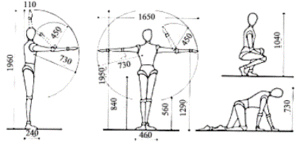Introduction
Ergonomics is the discipline that join the knowledge and the applications of such multiple specialities as the Engineering, Health, Hygiene and Security Psychology, Sociology, Labor Relations.
Definition
» The scientific discipline related to the comprehension of interactions between the human beings and other elements of a system «.
BENEFITS OF THE ERGONOMICS
Classification
-Proactive ergonomics: it is the one that applies to herself in the stage of design, or practical that corrections before consequences of the evil happen design of the position on the worker.
-Ergonomics Reactivate: that is the one that deals with the redesign and / or the establishment of ergonomic improvements to the position, after the complaint of the operator.
Other classifications are:
-Environmental (noise, lighting).
-Temporary Organizacional (shifts, pauses, pace of work).
– Cognitive (mental load, psychological factors).
– Geometric ergonomics (positional comfort).
– The ergonomics apply beginning of biology, psychology, anatomy and physiology to suppress of the labor area the situations that can provoke in the workers inconvenience, fatigue or bad health. It is possible to use the ergonomics to prevent a working place from designing badly if it is applied when there are conceived a working place, tools or places of work.
– The term Proactive Ergonomics mean to look for alternatives in the design of the work that there avoid the fatigue and the depletion of the worker, in order to promote the human productivity. He is an interdisciplinary approach of investigators and doctors of very diverse fields joined by the same aim, and part of a general base for a modern conception of the health and the safety in the work.
ANTHROPOMETRY
-The study of the physical measures of the body is realized by means of the Anthropometry (Anthropo: human body; metry: measures).
-In the application of physical methods it gives as proved information of a specific population, who describes sizes, forms, serving as model for the development of the standards of designs.
-It is the one that deals specially with the hard-working population, with both sexes and between ages from 18 to 65 years; his purpose is the job design, the models biomechanical and the such finished products as tools, machines, etc.

AREAS AND VOLUMES OF WORK
-It is known as normal area of work to the sector where the movement of the top members can be realized by the minor metabolic expense.
-Volumes of work from the ergonomic point of view are those who can be handled inside the zone or space of scope.
FARLEYS AREAS – scopes
-The working space is the space assigned to a group of persons, in the system of work to fulfill the task. It is known as working place to the place where an individual realizes his task, integrated also by the furniture, machine, tools, etc.
– The working place must be studied to the ends of the design, considering all the adjustments that should be done in order that the person could get out of a jam in comfortable way and without suffering sufferings as consequences of his work.
– From the stage of the design we must consider the ergonomic factors of risk: position, force and repetitiveness.
– It is known by position of work to the stopped, sat, bent, stretched out decubitus, etc.
– The seated position, which is stabler, supposes therefore a minor energetic expense and therefore a minor fatigue. Nevertheless always we must think that the best alternative is the variation of the position.
– Wisner developed what is known as » angles of comfort » that establish the maximum and minimal limits of opening where the joints are not submitted to tensions over the normal thing.
IMPORTANCE OF THE DESIGN
– The ergonomics consider all the aspects that affect the worker, there is therefore necessary the study of the measures of the body, realized by means of the Anthropometry.
– Statistics: Provided that the persons show variability in the dimensions of the body it is necessary to specify the information antropométricos in term of statistical numbers named percentiles, which indicate the quantity of the population who is inside Gausss curve.
– It is accepted that an ergonomic design must be valid for 90 % of the population.
THE PROBLEMS OF BAD DESIGN
1 Consequences of an evil job design.
– Absenteeism, Rotation, Complaints.
– Deficient performance
– Major possibility of accident.
– Problems of production.
– Minor quality.
2 Effects of the areas with problems of short-term design.
– Inconvenience.
– Visual fatigue.
– Some type of pain.
– Mental stress.
3 Effects of the areas with problems of long-term design.
– Syndrome of the tunnel carpiano
– Lumbalgia – Tendinitis
OCCUPATIONAL BIOMECHANICS
It uses laws of the physics, concepts of engineering and biological sciences, to describe movements realized by several corporal segments and forces that act on these parts of the body during an activity that should realize manual efforts in the work. »
It makes alike to the structures of the body that of a machine, such as the bones to links and joints of the kneecaps. The study biomechanics, it allows us to know maximum loads in different positions. It us demonstrates that in the very high efforts, serious injuries can happen, and incapacitantes, or for gradual deterioration of the fabrics throughout weeks or years, causing musculoskeletal disorders.
The biomechanics used in the Ergonomics; he studies the physical interaction of the worker with his tools, machines and materials in order to increase the performance.
Conclusion
The ergonomics, anthropometry and the occupational biomechanical are very important branches not only to assure the health and safety inside the work, but also they serve for the daily life since at all time it acts from raising something correctly to simply sitting down of correct form. That ´s the reason why , these three sciences work hard to know the limits of the human body to do sure possitions and procedures for every situation.







VERY GOOD NOTE!